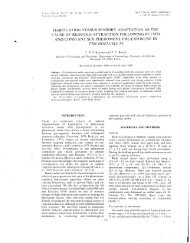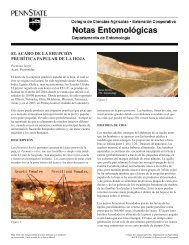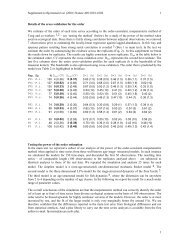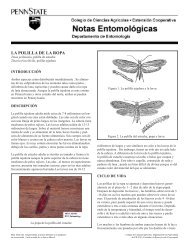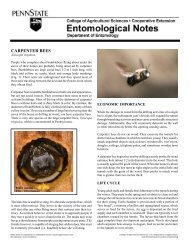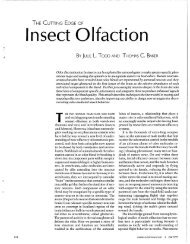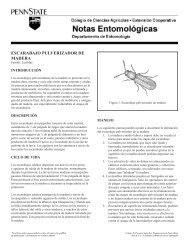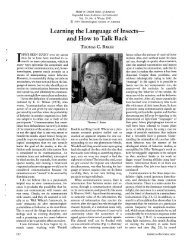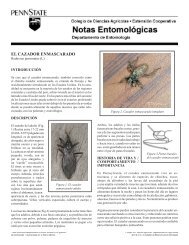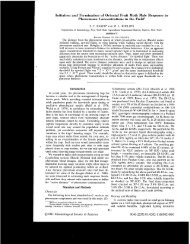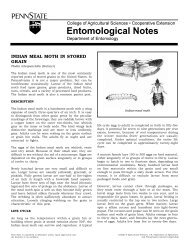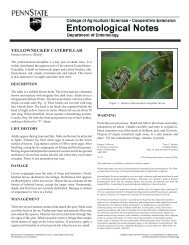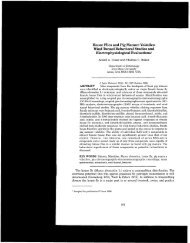Aphids on Ornamentals - Department of Entomology
Aphids on Ornamentals - Department of Entomology
Aphids on Ornamentals - Department of Entomology
Create successful ePaper yourself
Turn your PDF publications into a flip-book with our unique Google optimized e-Paper software.
College <strong>of</strong> Agricultural Sciences • Cooperative Extensi<strong>on</strong><br />
Entomological Notes<br />
<strong>Department</strong> <strong>of</strong> <strong>Entomology</strong><br />
APHIDS ON ORNAMENTALS<br />
Many species <strong>of</strong> aphids or plant lice occur <strong>on</strong> ornamental<br />
trees and shrubs in Pennsylvania Certain species<br />
feed <strong>on</strong> foliage, others <strong>on</strong> twigs and branches, flowers<br />
or fruit, and some <strong>on</strong> roots <str<strong>on</strong>g>Aphids</str<strong>on</strong>g> live <strong>on</strong> several<br />
distinct hosts, spending part <strong>of</strong> their seas<strong>on</strong>al development<br />
<strong>on</strong> <strong>on</strong>e host and the remainder <strong>on</strong> another They<br />
feed <strong>on</strong> both c<strong>on</strong>iferous and deciduous plants Effective<br />
c<strong>on</strong>trol <strong>of</strong> aphids has been a problem to homeowners<br />
and landscape managers for years Some <strong>of</strong> the more<br />
comm<strong>on</strong> aphids include the green peach aphid, mel<strong>on</strong><br />
aphid, tuliptree aphid, giant bark aphid, white pine<br />
aphid, and rose aphid<br />
DESCRIPTION<br />
<str<strong>on</strong>g>Aphids</str<strong>on</strong>g> c<strong>on</strong>stitute a large group <strong>of</strong> small, s<strong>of</strong>t-bodied<br />
insects They may measure up to six mm in total<br />
length <str<strong>on</strong>g>Aphids</str<strong>on</strong>g> have piercing-sucking mouth parts<br />
that enable them to remove plant fluids from a host<br />
<str<strong>on</strong>g>Aphids</str<strong>on</strong>g> generally can be recognized by their pear-like<br />
shape, a pair <strong>of</strong> cornicles (tube-like processes) at the<br />
posterior end <strong>of</strong> their body, and fairly l<strong>on</strong>g antennae<br />
(Fig 1) The cornicles secrete a defensive fluid which<br />
warns aphids <strong>of</strong> predators and other enemies <str<strong>on</strong>g>Aphids</str<strong>on</strong>g><br />
vary in color from green, yellow, red, purple, brown, or<br />
black<br />
LIFE HISTORY<br />
The life history <strong>of</strong> many aphids is complex and unusual<br />
Enormous populati<strong>on</strong>s <strong>of</strong> aphids can be built up<br />
in a short period <strong>of</strong> time Although c<strong>on</strong>siderable variati<strong>on</strong><br />
occurs between species, a typical life history is<br />
described as follows <str<strong>on</strong>g>Aphids</str<strong>on</strong>g> generally overwinter as<br />
fertilized eggs With the approach <strong>of</strong> spring weather,<br />
the eggs hatch into nymphs which rapidly mature into<br />
wingless females Each <strong>of</strong> these aphids is resp<strong>on</strong>sible<br />
for producing a large col<strong>on</strong>y <strong>of</strong> aphids and is referred to<br />
as a “stem mother” Stem mothers produce female<br />
nymphs without mating (parthenogenetic reproducti<strong>on</strong>)<br />
Successive wingless generati<strong>on</strong>s are produced<br />
until the aphid col<strong>on</strong>y becomes overcrowded When<br />
overcrowding occurs, a generati<strong>on</strong> <strong>of</strong> winged females is<br />
produced that will migrate to other host plants These<br />
winged females are referred to as spring migrants<br />
Spring migrants c<strong>on</strong>tinue to produce successive generati<strong>on</strong>s<br />
until the end <strong>of</strong> the summer when winged<br />
males and females are produced The winged females<br />
return to the spring host They are sometimes referred<br />
to as fall migrants These individuals produce females<br />
which mate with males <strong>of</strong> the previous generati<strong>on</strong><br />
These mated females lay eggs that overwinter<br />
DAMAGE<br />
Figure 1 A wingless aphid<br />
<str<strong>on</strong>g>Aphids</str<strong>on</strong>g> are comm<strong>on</strong>, persistent, and sometimes troublesome<br />
pests <strong>of</strong> ornamental plants Most aphids cause<br />
damage to host plants by robbing them <strong>of</strong> plant fluid, by<br />
the toxic acti<strong>on</strong> <strong>of</strong> their salivary secreti<strong>on</strong>s injected<br />
during feeding, and by serving as vectors <strong>of</strong> viruses<br />
that are harmful to plants Feeding by aphids can stunt<br />
plant growth, deform leaves and fruit, or cause galls <strong>on</strong><br />
leaves, stems and even roots Many aphids also excrete<br />
a sticky, sugar-c<strong>on</strong>taining substance from their anus<br />
known as “h<strong>on</strong>eydew” This material will drop <strong>on</strong>to the<br />
leaves, twigs, and fruit <strong>of</strong> a plant A black, sooty mold<br />
so<strong>on</strong> begins to grow <strong>on</strong> this sugar-rich substrate This<br />
mold not <strong>on</strong>ly mars the appearance <strong>of</strong> the plant, but<br />
when abundant, will also reduce the food-making process<br />
<strong>of</strong> a plant known as photosynthesis H<strong>on</strong>eydew is<br />
attractive to ants, flies, hornets, and yellowjackets It<br />
can also mar cars, chairs, tables, or other objects that<br />
are beneath aphid-infested plants<br />
Penn State is committed to affirmative acti<strong>on</strong>, equal opportunity and<br />
the diversity <strong>of</strong> its workforce<br />
College <strong>of</strong> Agricultural Sciences, US <strong>Department</strong> <strong>of</strong> Agriculture,<br />
and Pennsylvania Counties Cooperating
MANAGEMENT<br />
N<strong>on</strong>-Chemical<br />
In some cases, cultural practices such as proper pruning,<br />
fertilizing, and watering play an important role in<br />
preventing or suppressing an aphid infestati<strong>on</strong> When<br />
practical, try washing aphids <strong>of</strong>f an affected host with<br />
a str<strong>on</strong>g stream <strong>of</strong> water<br />
Beneficial insects play an important role in aphid<br />
c<strong>on</strong>trol Ladybird beetles (both adults and larvae), lacewings,<br />
some flower flies (larvae), and tiny parasitic<br />
wasps will use aphids as a source <strong>of</strong> nourishment for<br />
their development Remember certain insecticide applicati<strong>on</strong>s<br />
will destroy these beneficial insects as well<br />
as targeted pest species This practice could leave<br />
trees and shrubs unprotected if pest populati<strong>on</strong>s should<br />
increase in the future<br />
Chemical<br />
The use <strong>of</strong> insecticides is <strong>of</strong>ten the <strong>on</strong>ly effective<br />
means <strong>of</strong> c<strong>on</strong>trolling an aphid infestati<strong>on</strong> A number <strong>of</strong><br />
registered formulati<strong>on</strong>s <strong>of</strong> insecticides are available<br />
for aphid c<strong>on</strong>trol However, to avoid damaging valuable<br />
plants, apply the material <strong>on</strong>ly to plants that are<br />
specified <strong>on</strong> the label Be sure to follow all insecticide<br />
label directi<strong>on</strong>s<br />
WARNING<br />
Pesticides are pois<strong>on</strong>ous Read and follow directi<strong>on</strong>s<br />
and safety precauti<strong>on</strong>s <strong>on</strong> labels Handle carefully and<br />
store in original labeled c<strong>on</strong>tainers out <strong>of</strong> the reach <strong>of</strong><br />
children, pets, and livestock Dispose <strong>of</strong> empty c<strong>on</strong>tainers<br />
right away, in a safe manner and place Do not<br />
c<strong>on</strong>taminate forage, streams, or p<strong>on</strong>ds<br />
Gregory A Hoover<br />
Sr Extensi<strong>on</strong> Associate<br />
Dept <strong>of</strong> <strong>Entomology</strong><br />
Revised March 2004<br />
TS-1 ©The Pennsylvania State University 2004<br />
This publicati<strong>on</strong> is available in alternative media <strong>on</strong> request.<br />
Where trade names are used, no discriminati<strong>on</strong> is intended and no endorsement by The Pennsylvania State<br />
University or Pennsylvania <strong>Department</strong> <strong>of</strong> Agriculture is implied<br />
Entomological Notes are intended to serve as a quick reference guide and should not be used as a substitute<br />
for product label informati<strong>on</strong> Although every attempt is made to produce Entomological Notes that are<br />
complete, timely, and accurate, the pesticide user bears the resp<strong>on</strong>sibility <strong>of</strong> c<strong>on</strong>sulting the pesticide label and<br />
adhering to those directi<strong>on</strong>s<br />
Issued in furtherance <strong>of</strong> Cooperative Extensi<strong>on</strong> Works, Acts <strong>of</strong> C<strong>on</strong>gress May 8 and June 30, 1914, in<br />
cooperati<strong>on</strong> with the US <strong>Department</strong> <strong>of</strong> Agriculture and the Pennsylvania Legislature TR Alter, Director<br />
<strong>of</strong> Cooperative Extensi<strong>on</strong>, The Pennsylvania State University<br />
The Pennsylvania State University is committed to the policy that all pers<strong>on</strong>s shall have equal access to<br />
programs, facilities, admissi<strong>on</strong>, and employment without regard to pers<strong>on</strong>al characteristics not related to<br />
ability, performance, or qualificati<strong>on</strong>s as determined by University policy or by state or federal authorities<br />
It is the policy <strong>of</strong> the University to maintain an academic and work envir<strong>on</strong>ment free <strong>of</strong> discriminati<strong>on</strong>,<br />
including harassment The Pennsylvania State University prohibits discriminati<strong>on</strong> and harassment against<br />
any pers<strong>on</strong> because <strong>of</strong> age, ancestry, color, disability or handicap, nati<strong>on</strong>al origin, race, religious creed, sex,<br />
sexual orientati<strong>on</strong>, or veteran status Discriminati<strong>on</strong> or harassment against faculty, staff, or students will not<br />
be tolerated at The Pennsylvania State University Direct all inquiries regarding the n<strong>on</strong>discriminati<strong>on</strong> policy<br />
to the Affirmative Acti<strong>on</strong> Director, The Pennsylvania State University, 328 Bouke Building, University Park,<br />
PA 16802-5901, Tel 814-865-4700/V, 814-863-1150/TTY



